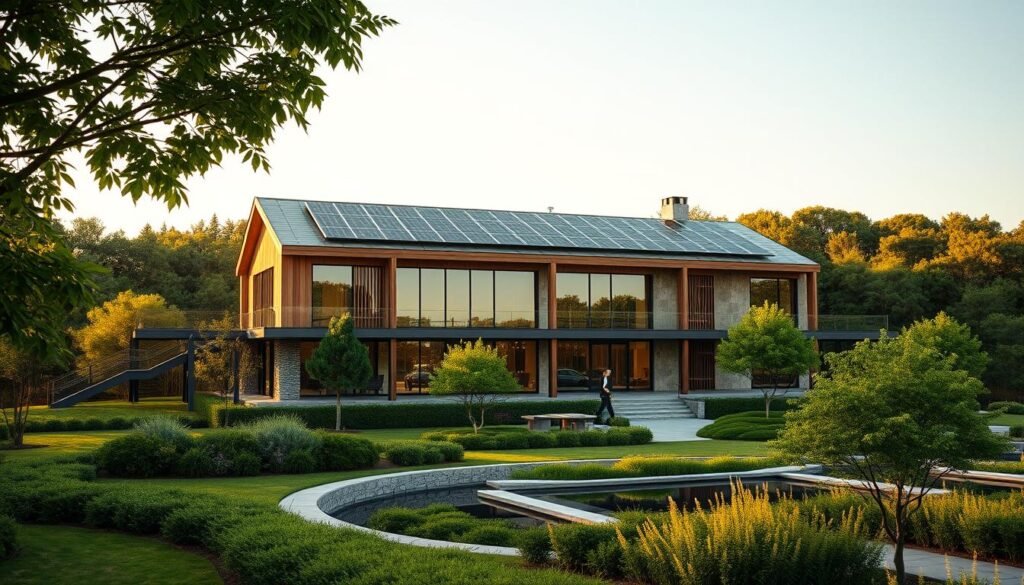The real estate landscape is undergoing significant transformations. These changes are driven by economic fluctuations, regulatory changes, and technological innovations. Recent data shows a notable shift in the housing sector. Various factors are contributing to this evolution.
As the housing market continues to adapt, understanding the underlying trends is essential. The interplay between economic conditions, regulatory frameworks, and technological advancements is reshaping the realty market profoundly.
Key Takeaways
- The real estate market is being reshaped by economic shifts and technological innovations.
- Regulatory pressures are significantly influencing the housing market.
- Understanding these trends is vital for stakeholders.
- The interplay between economic conditions and technological advancements is key.
- Adaptation to these changes is vital for success in the evolving realty market.
The Current State of the U.S. Realty Market
The U.S. realty market today is complex, shaped by many factors. These include economic indicators, regional differences, and changing consumer tastes.
Key Market Indicators and Statistics
The U.S. realty market is defined by several key indicators. They offer insights into its current condition.
Home Price Trends
Home prices have steadily increased, with some areas showing more growth. The national median home price has climbed, driven by low inventory and high demand.
Inventory Levels and Days on Market
Inventory levels are low, making the market competitive. The average days on market have dropped, showing a seller’s market.
Sales Volume Metrics
Sales volume has risen, with many areas seeing increased transaction volumes. This increase is partly due to favorable financing options and growing consumer confidence.
Regional Market Variations Across America
The U.S. realty market is not uniform; it varies significantly across different regions.
Coastal vs. Inland Markets
Coastal markets are more volatile, influenced by external factors like international investment. In contrast, inland markets tend to be more stable.
Urban vs. Rural Disparities
There’s a notable gap between urban and rural areas. Urban centers usually see higher demand and price growth.
Emerging Hotspot Markets
Emerging markets, like the Sunbelt region, are gaining popularity. Cities like Dallas/Fort Worth and parts of Florida are experiencing significant improvements.
The current state of the U.S. realty market is complex. It’s influenced by economic trends, regional characteristics, and consumer behavior.
Economic Factors Influencing Real Estate Decisions
The global economy’s evolution brings several key factors to the forefront, impacting housing affordability and property demand. Central banks in major economies are now lowering interest rates. Simultaneously, fears of a global recession are easing.
The relationship between economic factors and real estate choices is complex. It’s essential for buyers, sellers, and investors to grasp these dynamics. This knowledge aids in making informed decisions.
Interest Rate Impacts on Buying Power
Interest rates directly influence buying power. Lower rates make borrowing cheaper, boosting demand for properties. On the flip side, higher rates increase borrowing costs, reducing demand. With rates trending downward, buyers now have more purchasing power.
Inflation Effects on Housing Affordability
Inflation erodes consumer purchasing power, impacting housing affordability. As inflation climbs, living costs rise, potentially pricing buyers out. Yet, real estate often acts as an inflation hedge. Property values and rents tend to rise with inflation.
Employment Trends and Property Demand Correlation
Employment trends greatly affect property demand. Areas with robust job markets and low unemployment rates see increased housing demand. This drives up property values. In contrast, regions with weak employment trends face decreased demand and possibly stagnant or falling property values.
| Economic Factor | Impact on Real Estate |
|---|---|
| Interest Rates | Influences buying power and demand |
| Inflation | Affects housing affordability and property values |
| Employment Trends | Influences property demand and values |
Residential Housing Trends Shaping the Market
The real estate market is undergoing significant changes, with several key trends reshaping the residential housing sector. These trends are influenced by economic conditions, demographic shifts, and changing consumer preferences. They play a critical role in shaping the dynamics of the residential housing market.
Single-Family Home Market Dynamics
The single-family home market is undergoing a significant transformation. This shift is driven by increased demand for spacious living areas and suburbanization trends. The desire for more space and comfort, post-pandemic, has led to a notable increase in single-family home sales in certain regions.
Condominium and Townhouse Development Patterns
Condominium and townhouse developments are also experiencing changes. There is a growing focus on luxury amenities and sustainable building practices. These developments are gaining popularity, attracting younger demographics and urban dwellers where space is scarce. The trend towards denser living arrangements reflects changing lifestyles and preferences.
Rental Market Evolution and Investment Opportunity
The rental market is evolving, with increased investment in rental properties and a shift towards long-term rentals. This change is driven by the growing demand for rental housing, mainly among millennials and Gen Z. The rental income opportunity is making real estate investment more appealing, attracting many investors.
Commercial Real Estate Sector Analysis
The commercial real estate sector is undergoing significant transformations in response to changing market dynamics. As the industry adapts to new challenges and opportunities, several key trends are emerging.

The shift towards more flexible and technology-driven commercial spaces is redefining the way businesses operate. This transformation is most evident in the office space segment.
Office Space Transformation Post-Pandemic
The pandemic has accelerated the transformation of office spaces, with a growing emphasis on flexible work arrangements and hybrid workspaces. Companies are now focusing on creating more collaborative and adaptable environments.
- Increased demand for flexible lease terms
- Growing importance of technology integration
- Shift towards more collaborative workspaces
Retail Property Challenges and Adaptation Strategies
The retail property sector is facing significant challenges, including changing consumer behaviors and the rise of e-commerce. To adapt, retailers are focusing on creating experiential retail environments that combine shopping with entertainment and community engagement.
- Enhancing the in-store experience
- Integrating online and offline channels
- Creating community-focused retail spaces
Industrial and Warehouse Sector Explosive Growth
The industrial and warehouse sector is experiencing rapid growth driven by the expansion of e-commerce and the need for efficient logistics and distribution networks. The demand for data centers and edge facilities is also on the rise, fueled by the growth of AI and cloud computing.
Key trends in this sector include the development of more sophisticated logistics facilities and the increasing importance of proximity to urban areas.
Technology Disruption in the Realty Market
The real estate sector is undergoing a significant transformation with the integration of technology. This change is driven by digital innovations that boost efficiency, transparency, and accessibility in real estate services.
Digital Platforms Revolutionizing Property Transactions
Digital platforms are leading the technological disruption in real estate. They streamline property transactions by providing online services for both buyers and sellers.
iBuying Programs and Instant Offers
iBuying programs enable homeowners to sell properties quickly and efficiently online. They use data analytics and AI to determine fair market prices.
AI-Powered Property Valuation Tools
AI valuation tools improve property valuation accuracy. They analyze large datasets, including market trends and property characteristics.
Virtual and Augmented Reality in Property Marketing
VR/AR technologies are transforming property marketing. They offer immersive experiences for buyers, reducing the need for physical visits.
Blockchain Applications for Property Ownership
Blockchain technology is being explored for its ability to secure and transparently record property ownership. It makes buying, selling, and transferring property more efficient and fraud-resistant.
“Blockchain has the ability to disrupt the $1.4 trillion global real estate industry. It provides a secure, transparent, and efficient way to record property ownership.”
| Technology | Application in Real Estate | Benefits |
|---|---|---|
| Digital Platforms | Streamlining property transactions | Enhanced efficiency, transparency |
| VR/AR | Immersive property marketing | Remote property tours, enhanced buyer experience |
| Blockchain | Securing property ownership records | Reduced fraud, increased transparency |
Sustainable and Green Building Momentum
As environmental concerns escalate, the real estate sector is embracing green building practices more than ever. Sustainability is now a major focus, leading to significant investments in transforming outdated office buildings into eco-friendly offices or life science facilities.
Energy-Efficient Housing Demand Growth
The demand for energy-efficient homes is skyrocketing. Homeowners are now more aware of environmental issues and the long-term financial benefits of green buildings. Energy-efficient features not only cut down on carbon emissions but also boost a building’s market value.
Solar Integration and Smart Home Features
The trend of incorporating solar panels and smart home technologies in new constructions is gaining momentum. These innovations help lower energy consumption and give homeowners better control over their energy use.
Insulation and HVAC Efficiency Priorities
Enhancing insulation and HVAC efficiency are critical in energy-efficient homes. Adequate insulation reduces heat loss, while advanced HVAC systems ensure optimal air quality and temperature control.
Environmental Certifications Impact on Property Value
Environmental certifications like LEED (Leadership in Energy and Environmental Design) and Energy Star are significantly impacting property values. These certifications are a measure of a building’s sustainability and energy efficiency.
LEED Certification Premium
Properties with LEED certification often see a premium due to their adherence to sustainability standards. This certification is awarded to buildings that meet rigorous criteria for energy efficiency, water usage, and environmental quality.
Energy Star and Other Rating Systems
Energy Star and other rating systems offer valuable insights into a property’s energy efficiency. These ratings empower homeowners and buyers to make informed decisions about their investments.
| Certification | Description | Benefits |
|---|---|---|
| LEED | Leadership in Energy and Environmental Design | Recognized sustainability standards, premium property value |
| Energy Star | Energy efficiency rating | Informative decision-making, reduced energy consumption |

Demographic Shifts Affecting Housing Demand
Demographic changes are reshaping housing demand across the United States. Different groups have unique housing needs and preferences, impacting demand profoundly. As the population evolves, grasping these shifts is vital for real estate stakeholders.
Millennial Homebuying Patterns and Preferences
Millennials, a major segment of today’s buyers, show distinct preferences. They value location, seeking urban or suburban areas with amenities and good commute options. Affordability is a top concern, leading many to choose starter homes or delay purchases due to financial reasons. They also seek sustainable and tech-enabled homes, reflecting their eco-conscious and tech-savvy lifestyle.
Baby Boomer Housing Transitions and Downsizing Trends
Baby boomers, as they age, are altering housing demand. Many are moving to retirement communities or downsizing to smaller homes, driven by lifestyle changes and a desire for simplicity. This trend opens up opportunities in the market for age-restricted communities and senior living facilities. Baby boomers’ preferences for aging-in-place features and accessible design are also influencing home development.
Urban vs. Suburban Development Patterns
Urban and suburban development are undergoing a significant transformation. This change is driven by shifts in work patterns and lifestyle preferences. The lines between urban and suburban living are blurring, influenced by remote work, migration trends, and infrastructure advancements.
Post-Pandemic Migration Trends and Remote Work Impact
The pandemic has dramatically altered migration patterns. Many individuals and families are moving from cities to suburbs in pursuit of more space and a superior quality of life. Remote work has been instrumental in this migration, enabling people to reside farther from their workplaces.
This shift profoundly impacts housing demand and property values in suburban locales. These areas are now seeing a surge in demand for single-family homes and other housing types.

Infrastructure Development Influence on Property Values
Infrastructure development is vital in shaping property values in both urban and suburban settings. Investments in transportation, schools, and public amenities greatly enhance a neighborhood’s appeal.
| Development Type | Impact on Property Values |
|---|---|
| Transportation Infrastructure | Increases accessibility, boosting property values |
| Public Amenities | Enhances quality of life, attracting more residents |
| School Districts | Improves educational opportunities, increasing demand for housing |
Investment Strategies in Today’s Property Market
Understanding the complex property market today is essential. Investors aim to boost their returns amidst changing interest rates, shifting consumer tastes, and economic instability. This requires a solid grasp of effective investment strategies.
REITs and Alternative Real Estate Investment Vehicles
Investing in Real Estate Investment Trusts (REITs) and other real estate options is gaining traction. REITs enable individuals to invest in real estate without the hands-on management, diversifying their portfolios and potentially increasing returns. Platforms for real estate crowdfunding offer more ways to engage with the property market.
Fix-and-Flip vs. Buy-and-Hold Approaches in Current Conditions
Investors face a choice between fix-and-flip and buy-and-hold strategies. The fix-and-flip method involves buying, renovating, and selling properties for a quick profit, ideal in a rising market. On the other hand, the buy-and-hold strategy aims for long-term rental income and property value growth, ensuring steady cash flow. Each method has its pros and cons, influenced by the investor’s financial objectives, risk tolerance, and the market’s state.
Regulatory Changes Impacting the Housing Industry
Regulatory shifts are deeply affecting the housing sector, altering everything from housing density to investment strategies. These changes encompass updates to zoning laws, tax policies, and other regulatory frameworks that shape the industry.
Zoning Law Developments and Housing Density
Zoning laws are key in setting housing density and neighborhood character. Recent zoning law updates aim to tackle affordable housing shortages and urban sprawl. For example, cities are adopting inclusionary zoning policies. These require developers to include a specific percentage of affordable housing in new projects.
| City | Zoning Law Change | Impact on Housing Density |
|---|---|---|
| New York City | Inclusionary Zoning | Increased affordable housing units |
| San Francisco | Density Bonus Program | Higher density in certain areas |
| Seattle | Mandatory Housing Affordability | More affordable units in new developments |
Tax Policy Effects on Real Estate Ownership and Investment
Tax policies have a significant impact on real estate ownership and investment choices. Alterations in tax laws, like those affecting capital gains tax or property tax deductions, can change real estate investment appeal. For instance, the Tax Cuts and Jobs Act introduced limits on state and local tax (SALT) deductions, affecting homeowners in high-tax states.

The effects of these regulatory changes are widespread, influencing not just homeowners and investors but the entire housing market. Grasping these changes is essential for navigating today’s real estate landscape.
Conclusion: Future Outlook for the Realty Market
The future of the realty market will be influenced by several factors. These include economic indicators, technological advancements, and demographic shifts.
The U.S. realty market is currently shaped by interest rates, inflation, and employment trends. These elements will continue to affect real estate trends in the years ahead.
Important trends to observe include the rise of sustainable and green building. Also, changes in residential housing preferences and the evolution of commercial real estate are noteworthy. The future outlook for the realty market points towards a continued move towards digital platforms and innovative technologies.
- Increased adoption of digital platforms in property transactions
- Growing demand for energy-efficient housing
- Evolution of commercial real estate post-pandemic
As the realty market evolves, it’s vital for investors, homeowners, and industry professionals to stay updated. They must be aware of the latest real estate trends and future outlook.
Sources
This article draws on various industry reports and analyses from trusted sources. For deeper insights, the following references offer valuable perspectives on the realty market’s evolution.
Market research reports from Zillow and Redfin are among the key sources. They provide detailed analyses of market trends and statistics. The National Association of Realtors also offers authoritative data on the U.S. real estate market through its industry analyses.
For additional information, refer to the sources listed below:
- Center on Budget and Policy Priorities
- Jones Lang LaSalle
- National Association of Realtors
These sources and references provide a thorough understanding of the real estate market’s current state. They support the discussions and analyses in this article.
FAQ
What are the key factors influencing the U.S. realty market?
The U.S. realty market is shaped by economic shifts, regulatory changes, and technological progress. These elements impact home prices, inventory levels, and sales volume.
How do interest rates affect buying power in the real estate market?
Interest rates play a significant role in the real estate market. Changes in rates can make homes more or less affordable. This, in turn, affects demand and the overall market.
What is the current trend in the single-family home market?
The single-family home market is undergoing significant changes. Factors like affordability, employment, and demographic shifts are reshaping residential trends.
How is technology disrupting the realty market?
Technology is transforming the realty market. Digital platforms, virtual and augmented reality, and blockchain are changing how we buy, market, and own properties.
What is the impact of sustainable and green building practices on property value?
Sustainable and green building practices are boosting property value. They offer long-term savings and appeal to eco-conscious buyers, positively impacting property value.
How are demographic shifts affecting housing demand?
Demographic shifts, like those among millennials and baby boomers, are shaping housing demand. Their buying patterns and preferences are influencing the residential market.
What are the investment strategies in today’s property market?
Investors are using REITs and alternative vehicles in today’s market. They’re adopting strategies like fix-and-flip versus buy-and-hold, tailored to current conditions.
How do zoning laws and tax policies impact the housing industry?
Zoning laws and tax policies have a significant impact on the housing industry. They affect density, ownership, and investment, shaping market trends.
What is the outlook for the realty market based on current trends and factors?
The realty market’s future is influenced by ongoing trends and factors. Economic changes, technological advancements, and demographic shifts will continue to shape the market.
What are the emerging trends in commercial real estate?
Commercial real estate is seeing changes, like the transformation of office space post-pandemic. Retail faces challenges but is adapting. The industrial and warehouse sector is growing, driven by demand shifts.
